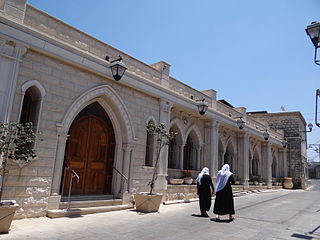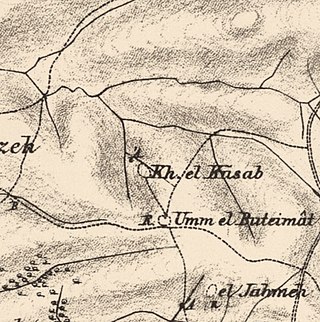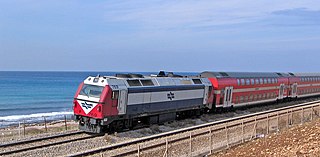
Haifa is the third-largest city in Israel—after Jerusalem and Tel Aviv—with a population of 290,306 in 2022. The city of Haifa forms part of the Haifa metropolitan area, the third-most populous metropolitan area in Israel. It is home to the Baháʼí Faith's Baháʼí World Centre, and is a UNESCO World Heritage Site and a destination for Baháʼí pilgrimage.

The Hejaz railway was a narrow-gauge railway that ran from Damascus to Medina, through the Hejaz region of modern-day Saudi Arabia, with a branch line to Haifa on the Mediterranean Sea. The project was ordered by Sultan Abdul Hamid II in March 1900.

Ramla or Ramle is a city in the Central District of Israel. Ramle is one of Israel's mixed cities, with significant numbers of both Jews and Arabs.

Shefa-Amr or Shfar'am is an Arab city in the Northern District of Israel. In 2022 it had a population of 43,543, with a Sunni Muslim majority and large Christian Arab and Druze minorities.

Haifa Airport, also known as Uri Michaeli Airport, is an international airport in Haifa, Israel. It is located to the east of the city, close to Kishon Port and Israel Shipyards and mainly serves civilian flights, with some military usage. The airport is named after Uri Michaeli, one of the pioneers of Jewish aviation and one of the founders of aviation in Israel. The airport has one short runway, 1,318 metres (4,324 ft) in length, and there are plans to extend it by 316 metres (1,037 ft).

Daliyat al-Karmel is a Druze town located on Mount Carmel in the Haifa District of Israel, around 20 km southeast of Haifa. In 2022 its population was 18,001.

HaMifratz Central railway station is an Israeli railway passenger station in Haifa, Israel co-located with the Haifa Bay central bus station. It serves Lev HaMifratz Mall, one of Haifa's largest malls, and the surrounding Haifa Bay industrial zone in the northeast of the city.

Haifa Center–HaShmona railway station is an Israel Railways passenger station situated on the coastal railway main line and serves the City of Haifa.

The German Colony is an area of Haifa established in 1868 during Ottoman rule as a Christian German Templer Colony in Palestine. It was the first of several colonies established by the group in the Holy Land. Others were founded in Sarona near Jaffa, Galilee and Jerusalem. Some of the original buildings are still surviving today, and the area continues to be visited, lived in, and in use.

Balad al-Sheikh or Balad ash-Shaykh was a Palestinian Arab village located just north of Mount Carmel, 7 kilometers (4.3 mi) southeast of Haifa. Currently the town's land is located within the jurisdiction of the Israeli city, Nesher.

The Jezreel Valley railway, or the Valley Train was a railroad that existed in Ottoman and British Palestine, reconstituted as a modern railway in Israel in the 21st century. It runs from the Mediterranean coast inland along the length of the Jezreel Valley. The historical line was a segment of the longer Haifa–Dera'a Line, which was itself a branch of the larger Hejaz railway.

The history of Haifa dates back before the 3rd century BCE. Since then it has been controlled by several civilizations, including the Canaanites, Israelites, Persians, Romans, Byzantines, Muslims, Crusaders, Kurds, the Mamluks, the Ottoman Turks and the British; currently it is a major city in Israel.

Isfiya, also known as Usfiya, is a Druze-majority village in northern Israel, governed by a local council. It also includes Christians, Muslims and a few Jewish households. Located on Mount Carmel, it is part of the Haifa District. In 2022 its population was 12,136. In 2003, the local council was merged with nearby Daliyat al-Karmel to form Carmel City. However, the new city was dissolved in 2008 and the two villages resumed their independent status.

Ayn Ghazal was a Palestinian Arab village located 21 kilometers (13 mi) south of Haifa. Depopulated during the 1948 Arab-Israeli War as a result of an Israeli military assault during Operation Shoter, the village was then completely destroyed. Incorporated into the State of Israel, it is now mostly a forested area. The Israeli moshav of Ofer ("fawn") was established in 1950 on part of the former village's lands. Ein Ayala, a moshav established in 1949, lies just adjacent; its name being the Hebrew translation of Ayn Ghazal.

Al-Butaymat was a Palestinian Arab village the Haifa Subdistrict, located 31 kilometers (19 mi) southeast of Haifa. It was depopulated during the 1947–48 Civil War in Mandatory Palestine on May 1, 1948, under the Battle of Mishmar HaEmek.

The Coastal railway line is a mainline railway in Israel, which begins just south of the Lebanon-Israel border on the Mediterranean coast, near the town of Nahariya in Northern Israel and stretches almost the entire Mediterranean coast of the country, to just north of the border with the Gaza Strip in the south.
The following is a timeline of the history of the city of Ankara, Ankara Province, Turkey.
The following is a timeline of the history of the city of Tel Aviv, Israel.
The following is a timeline of the history of Jaffa.
The following is a timeline of the history of the city of Hebron, West Bank, Palestinian territories.
















